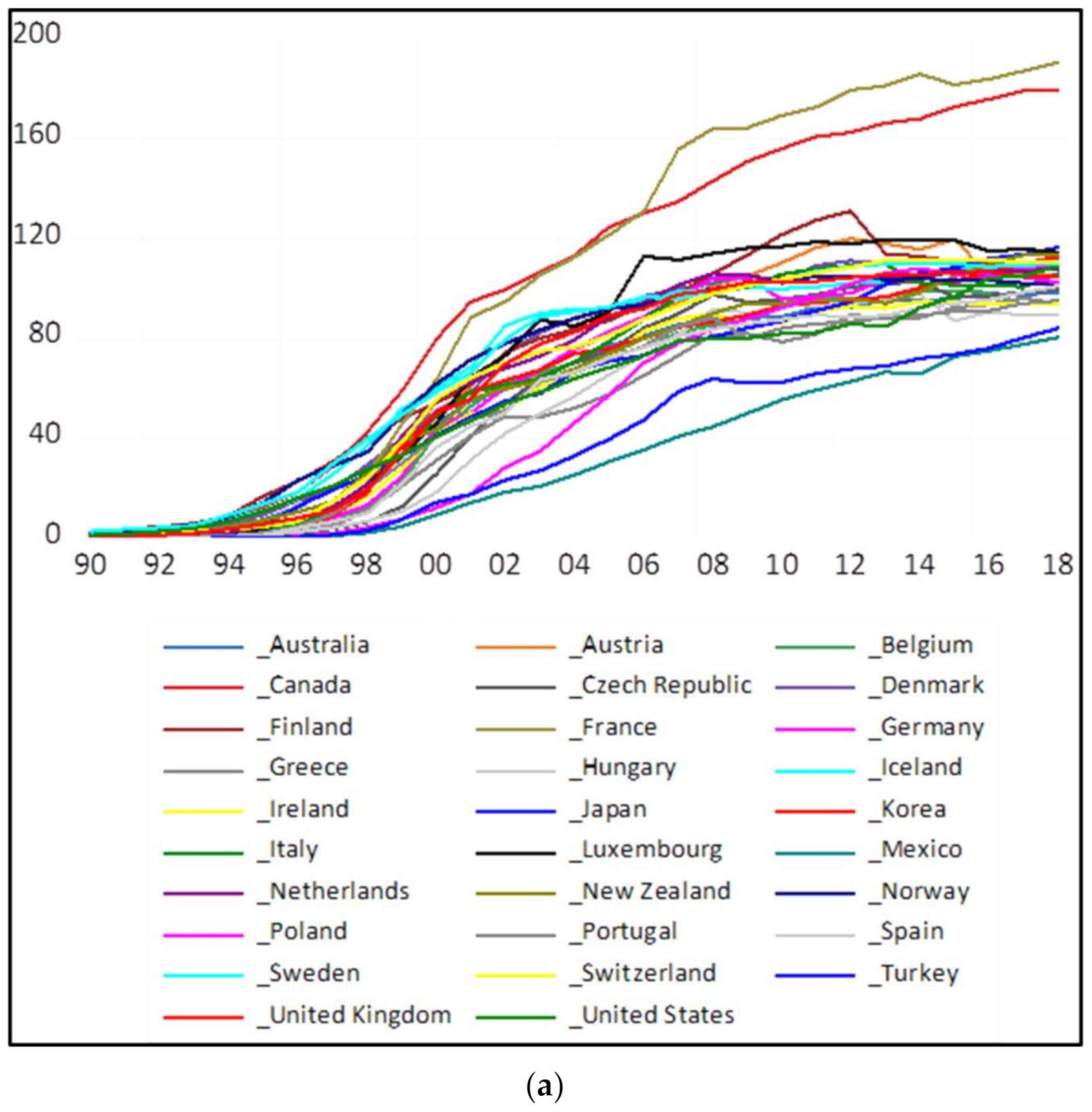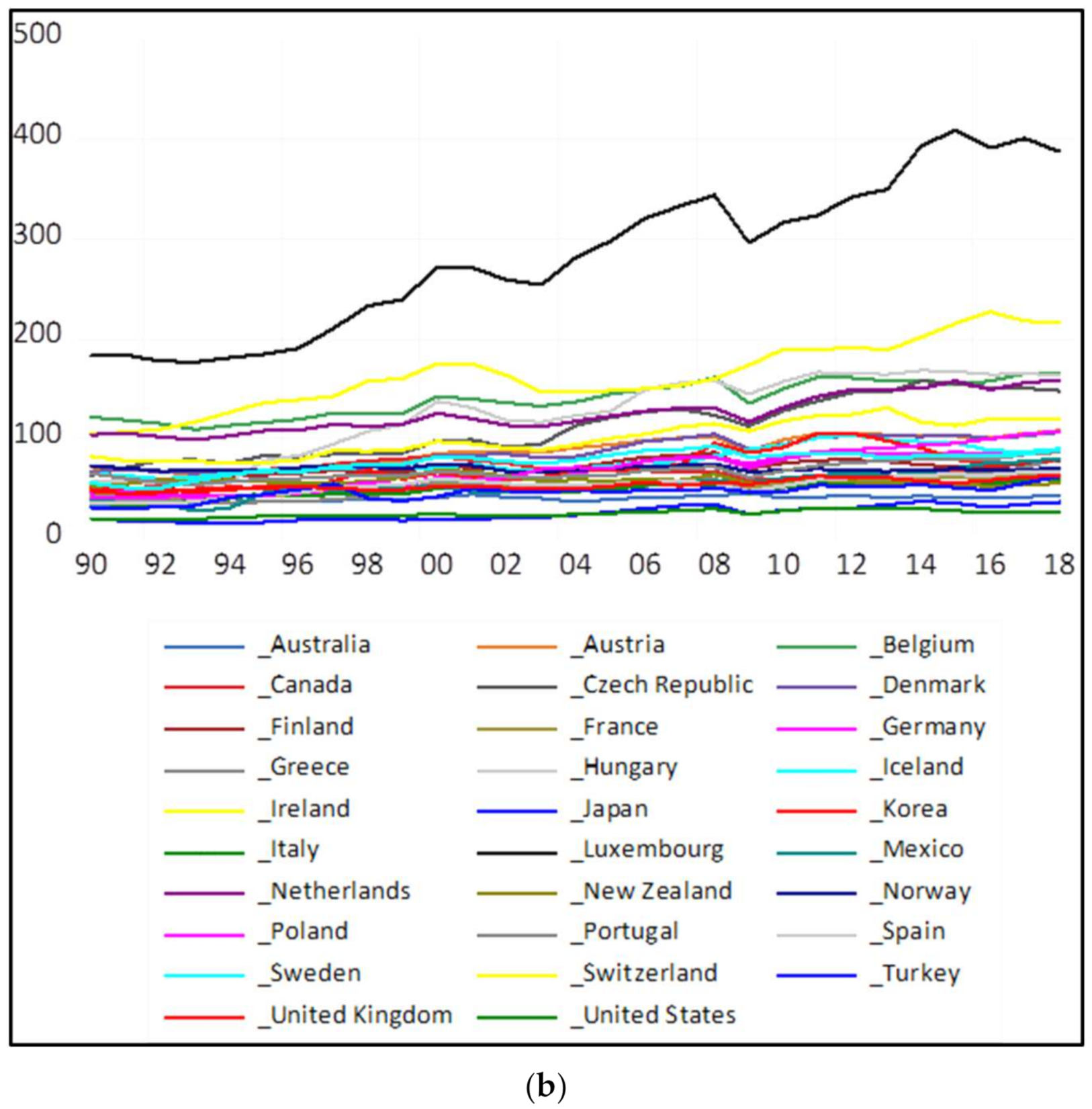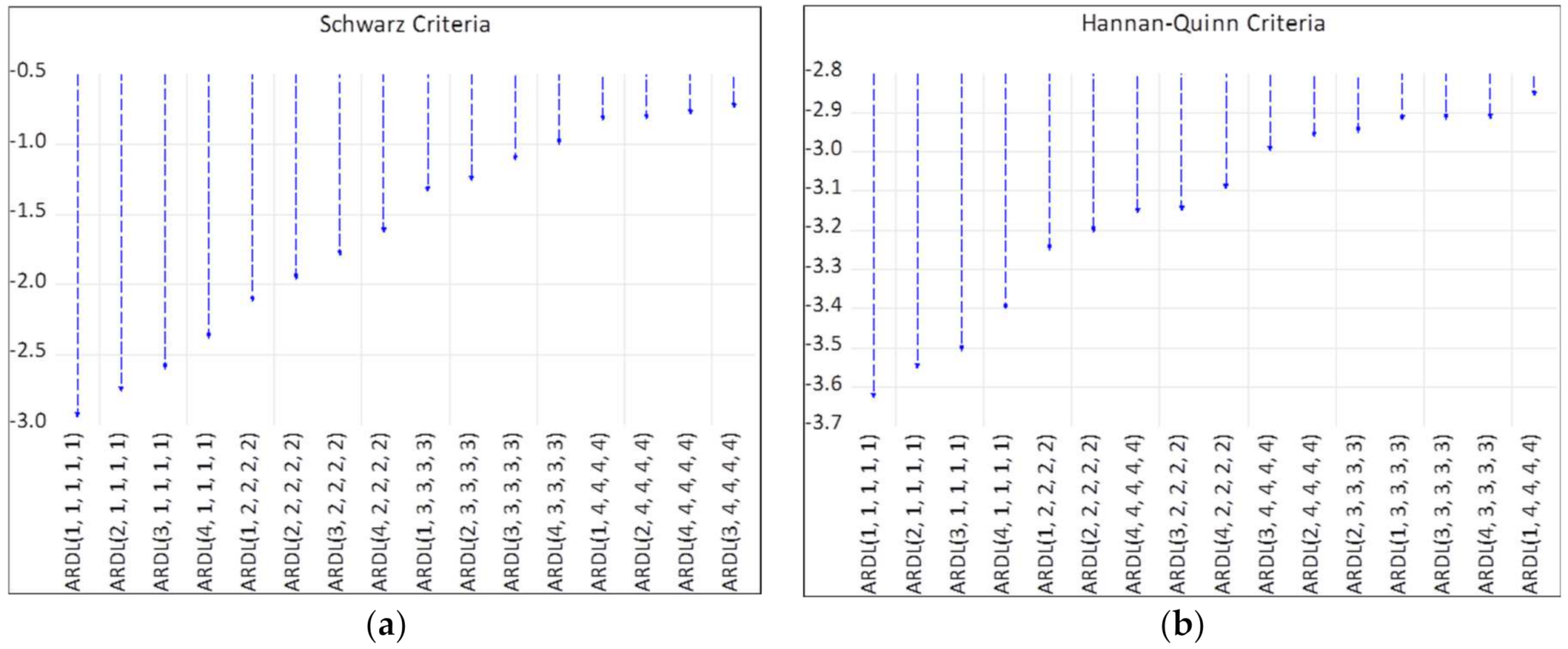The Effects of Information and Communication Technology, Economic Growth, Trade Openness, and Renewable Energy on CO2 Emissions in OECD Countries
Abstract
:1. Introduction
2. Literature Review
| Regions | Periods | Methods | Signs of ICT Variable on CO2 Emissions | |
|---|---|---|---|---|
| Higón et al. [4] | 116 developing and 26 developed countries | 1995–2010 | Pooled Ordinary Least Squares Driscoll–Kraay Fixed Effects model Instrumental variable Fixed Effect model | Negative |
| Lu [5] | 12 Asian countries 1 | 1993–2013 | Pedroni cointegration test | Negative |
| Ozcan and Apergis [6] | 20 emerging economies 2 | 1990–2015 | MG estimator GM FMOLS | Negative |
| Haseeb et al. [7] | BRICS countries 3 | 1994–2014 | FMOLS and DSUR | Negative |
| Faisal et al. [8] | Fast emerging countries 4 | 1993–2014 | FMOLS, DOLS, robust least square | Negative |
| Zhang and Liu [9] | China | 2000–2010 | STIRPAT | Negative |
| Park et al. [13] | EU countries 5 | 2001–2014 | MG estimator | Positive |
| Lee and Brahmasrene [14] | ASEAN countries 6 | 1991–2009 | FMOLS Canonical Cointegrating Regression Dynamic OLS | Positive |
| Salahuddin et al. [15] | OECD countries 7 | 1991–2012 | PMG, DOLS, FMOLS | Positive |
| Asongu et al. [16] | 44 countries in Sub-Saharan Africa | 2000–2012 | Generalized Method of Moments | Insignificant |
| Danish et al. [17] | 11 countries 8 | 1990–2014 | MG estimator | Positive |
| Amri [18] | Tunisia | 1975–2014 | ARDL | Insignificant |
| Shehzad [19] | Pakistan | 1990–2018 | STIRPAT and ARDL | Positive |
3. Data and Methods
4. Estimation Results
4.1. Unit Root Tests
4.2. Cointegration Tests
4.3. Long-Run Coefficients
4.4. Short Run Cofficients
5. Discussion
6. Conclusions and Policy Implications
Funding
Institutional Review Board Statement
Informed Consent Statement
Data Availability Statement
Acknowledgments
Conflicts of Interest
References
- World Bank DataBank. Available online: https://databank.worldbank.org/home.aspx (accessed on 1 June 2020).
- UNEP. DTU Data Centers: Digitalisation Powerhouse and Energy Efficiency Potential. 2020. Available online: https://c2e2.unepdtu.org/kms_object/data-centres-digitalisation-powerhouse-and-energy-efficiency-potential/ (accessed on 10 January 2022).
- Malmodin, J.; Bergmark, P. Exploring the effect of ICT solutions on GHG emissions in 2030. In Proceedings of the 29th International Conference on Informatics for Environmental Protection (EnviroInfo 2015) Third International Conference on ICT for Sustainability (ICT4S 2015), Copenhagen, Denmark, 7–9 September 2015. [Google Scholar]
- Higón, D.A.; Gholami, R.; Shirazi, F. ICT and environmental sustainability: A global perspective. Telemat. Inform. 2017, 34, 85–95. [Google Scholar] [CrossRef]
- Lu, W.C. The impacts of information and communication technology, energy consumption, financial development, and economic growth on carbon dioxide emissions in 12 Asian countries. Mitig. Adapt. Strateg. Glob. Chang. 2018, 23, 1351–1365. [Google Scholar] [CrossRef]
- Ozcan, B.; Apergis, N. The impact of internet use on air pollution: Evidence from emerging countries. Environ. Sci. Pollut. Res. 2018, 25, 4174–4189. [Google Scholar] [CrossRef] [PubMed]
- Haseeb, A.; Xia, E.; Saud, S.; Ahmad, A.; Khurshid, H. Does information and communication technologies improve environmental quality in the era of globalization? an empirical analysis. Environ. Sci. Pollut. Res. 2019, 26, 8594–8608. [Google Scholar] [CrossRef] [PubMed]
- Faisal, F.; Azizullah; Tursoy, T.; Pervaiz, R. Does ICT lessen CO2 emissions for fast-emerging economies? an application of the heterogeneous panel estimations. Environ. Sci. Pollut. Res. 2020, 27, 10778–10789. [Google Scholar] [CrossRef]
- Zhang, C.; Liu, C. The impact of ICT industry on CO2 emissions: A regional analysis in China. Renew. Sustain. Energy Rev. 2015, 44, 12–19. [Google Scholar] [CrossRef]
- Usman, A.; Ozturk, I.; Hassan, A.; Zafar, A.; Zafar, A.M.; Ullah, S. The effect of ICT on energy consumption and economic growth in South Asian economies: An empirical analysis. Telemat. Inform. 2021, 58, 101537. [Google Scholar] [CrossRef]
- Nguyen, T.T.N.; Pham, T.A.T.; Tram, H.T.X. Role of information and communication technologies and innovation in driving carbon emissions and economic growth in selected G-20 countries. J. Environ. Manag. 2020, 261, 110162. [Google Scholar] [CrossRef]
- Asoungu, S.A. ICT, openness and CO2 emissions in Africa. Environ. Sci. Pollut. 2018, 25, 9351–9359. [Google Scholar] [CrossRef] [Green Version]
- Park, Y.; Meng, F.; Baloch, M.A. The effect of ICT, financial development, growth, and trade openness on CO2 emissions: An empirical analysis. Environ. Sci. Pollut. Res. 2018, 25, 30708–30719. [Google Scholar] [CrossRef]
- Lee, J.W.; Brahmasrene, T. ICT, CO2 Emissions and Economic Growth: Evidence from a Panel of ASEAN. Glob. Econ. Rev. 2014, 43, 93–109. [Google Scholar] [CrossRef]
- Salahuddin, M.; Alam, K.; Ozturk, I. The effects of Internet usage and economic growth on CO2 emissions in OECD countries: A panel investigation. Renew. Sustain. Energy Rev. 2016, 62, 1226–1235. [Google Scholar] [CrossRef]
- Asongu, S.A.; Le Roux, S.; Biekpe, N. Enhancing ICT for environmental sustainability in sub-Saharan Africa. Technol. Forecast. Soc. Change 2018, 127, 209–216. [Google Scholar] [CrossRef] [Green Version]
- Khan, N.; Baloch, M.A.; Saud, S.; Fatima, T. The effect of ICT on CO2 emissions in emerging economies: Does the level of income matters? Environ. Sci. Pollut. Res. 2018, 25, 22850–22860. [Google Scholar] [CrossRef]
- Amri, F. Carbon dioxide emissions, total factor productivity, ICT, trade, financial development, and energy consumption: Testing environmental Kuznets curve hypothesis for Tunisia. Environ. Sci. Pollut. Res. 2018, 25, 33691–33701. [Google Scholar] [CrossRef]
- Shehzad, K.; Xiaoxing, L.; Sarfraz, M.; Zulfiqar, M. Signifying the imperative nexus between climate change and information and communication technology development: A case from Pakistan. Environ. Sci. Pollut. Res. 2020, 27, 30502–30517. [Google Scholar] [CrossRef]
- Raheem, I.D.; Tiwari, A.K.; Balsalobre-Lorente, D. The role of ICT and financial development in CO2 emissions and economic growth. Environ. Sci. Pollut. Res. 2020, 27, 1912–1922. [Google Scholar] [CrossRef] [Green Version]
- Magazzino, C.; Porrini, D.; Fusco, G.; Schneider, N. Investigating the link among ICT, electricity consumption, air pollution, and economic growth in EU countries. Energy Sources Part B Econ. Plan. Policy 2021, 16, 976–998. [Google Scholar] [CrossRef]
- Avom, D.A.; Nkengfack, H.; Fotio, H.K.; Totouom, A. ICT and environmental quality in Sub-Saharan Africa: Effects and transmission channels. Technol. Forecast. Soc. Change 2020, 155, 120028. [Google Scholar] [CrossRef]
- Alataş, S. The role of information and communication technologies for environmental sustainability: Evidence from a large panel data analysis. J. Environ. Manag. 2021, 293, 112889. [Google Scholar] [CrossRef]
- Menyah, K.; Wolde-Rufael, Y. CO2 emissions, nuclear energy, renewable energy and economic growth in the US. Energy Policy 2010, 38, 2911–2915. [Google Scholar] [CrossRef]
- Apergis, N.; Payne, J.E.; Menyah, K.; Wolde-Rufael, Y. On the causal dynamics between emissions, nuclear energy, renewable energy, and economic growth. Ecol. Econ. 2010, 69, 2255–2260. [Google Scholar] [CrossRef]
- Shafiei, S.; Salim, R.A. Non-renewable and renewable energy consumption and CO2 emissions in OECD countries: A comparative analysis. Energy Policy 2014, 66, 547–556. [Google Scholar] [CrossRef] [Green Version]
- Jaforullah, M.; King, A. Does the use of renewable energy sources mitigate CO2 emissions? A reassessment of the US evidence. Energy Econ. 2015, 49, 711–717. [Google Scholar] [CrossRef]
- Bilgili, F.; Koçak, E.; Bulut, Ü. The dynamic impact of renewable energy consumption on CO2 emissions: A Revisited Environmental Kuznets Curve approach. Renew. Sustain. Energy Rev. 2016, 54, 838–845. [Google Scholar] [CrossRef]
- Dogan, E.; Seker, F. Determinants of CO2 emissions in the European Union: The role of renewable and non-renewable energy. Renew. Energy 2016, 94, 429–439. [Google Scholar] [CrossRef]
- Ito, K. CO2 emissions, renewable and non-renewable energy consumption, and economic growth: Evidence from panel data for developing countries. Int. Econ. 2017, 151, 1–6. [Google Scholar] [CrossRef]
- Zoundi, Z. CO2 emissions, renewable energy and the Environmental Kuznets Curve, a panel cointegration approach. Renew. Sustain. Energy Rev. 2017, 72, 1067–1075. [Google Scholar] [CrossRef]
- Jebli, M.B.; Farhani, S.F.; Guesmi, K. Renewable energy, CO2 emissions and value added: Empirical evidence from countries with different income levels. Struct. Change Econ. Dyn. 2020, 53, 402–410. [Google Scholar] [CrossRef]
- Dong, K.; Hochman, G.; Zhang, Y.; Sun, R.; Li, H.; Liao, H. CO2 emissions, economic and population growth, and renewable energy: Empirical evidence across regions. Energy Econ. 2018, 75, 180–192. [Google Scholar] [CrossRef]
- Inglesi-Lotz, R.; Dogan, E. The role of renewable versus non-renewable energy to the level of CO2 emissions a panel analysis of sub-Saharan Africa’s Βig 10 electricity generators. Renew. Energy 2018, 123, 36–43. [Google Scholar] [CrossRef] [Green Version]
- Pesaran, M.H.; Shin, Y.; Smith, R.P. Pooled Mean Group Estimation of Dynamic Heterogeneous Panels. J. Am. Stat. Assoc. 1999, 94, 621–634. [Google Scholar] [CrossRef]
- Pesaran, M.H.; Smith, R.P. Estimating long-run relationships from dynamic heterogeneous panels. J. Econom. 1995, 68, 79–113. [Google Scholar] [CrossRef]
- Levin, A.; Lin, C.F.; Chu, C. Unit root tests in panel data: Asymptotic and Finite sample properties. J. Econom. 2002, 108, 1–24. [Google Scholar] [CrossRef]
- Im, K.S.; Pesaran, M.H.; Shin, Y. Testing for unit roots in heterogeneous panels. J. Econmetr. 2003, 115, 53–74. [Google Scholar] [CrossRef]
- Dickey, D.A.; Fuller, W.A. Distribution of the estimators for autoregressive time series with a unit root. J. Am. Stat. Assoc. 1979, 74, 427–431. [Google Scholar]
- Phillips, P.C.B.; Perron, P. Testing for a unit root in time series regression. Biometrika 1988, 75, 335–346. [Google Scholar] [CrossRef]
- Pedroni, P. Critical values for cointegration tests in heterogeneous panels with multiple regressors. Oxf. Bull. Econ. Stat. 1999, 61, 653–670. [Google Scholar] [CrossRef]
- Pedroni, P. Purchasing power parity tests in cointegrated panels. Rev. Econ. Stat. 2001, 83, 727–731. [Google Scholar] [CrossRef] [Green Version]
- Balsalobre-Lorente, D.; Shahbaz, M.; Roubaud, D.; Farhani, S. How economic growth, renewable electricity and natural resources contribute to CO2 emissions? Energy Policy 2018, 113, 356–367. [Google Scholar] [CrossRef] [Green Version]



| Variables | Unit | Sources |
|---|---|---|
| CO2 emissions (kt) | World Bank DataBank | |
| GDP per capita (2015 constant US dollar) | OECD.Stat | |
| Exports and imports of goods and services (% of GDP) | World Bank DataBank | |
| The weighted average of individuals using the Internet (% of population) and mobile cellular subscriptions (per 100 people) | World Bank DataBank | |
| Renewable electricity (% of total electricity generation) | OECD.Stat |
| 1 | |||||
| −0.2248 | 1 | ||||
| −0.6056 | 0.3986 | 1 | |||
| −0.0217 | 0.5089 | 0.2822 | 1 | ||
| −0.3892 | 0.3400 | −0.0073 | 0.2851 | 1 |
| Method | Statistic | Statistic | Statistic | Statistic | Statistic |
| Null: Unit root (assumes common unit root process) | |||||
| Levin et al. [16] t * | −3.009 *** | −5.346 *** | −21.864 *** | 1.590 | −3.022 *** |
| Null: Unit root (assumes individual unit root process) | |||||
| Im et al. [17] W | 0.182 | 1.578 | −23.650 *** | 3.099 | 1.315 |
| ADF-Fisher Chi-square | 71.507 | 52.770 | 472.404 *** | 41.062 | 44.502 |
| PP-Fisher Chi-square | 74.811 * | 75.663 | 501.827 *** | 42.358 | 56.493 |
| Method | Statistic | Statistic | Statistic | Statistic | Statistic |
| Null: Unit root (assumes common unit root process) | |||||
| Levin et al. [16] t * | −22.702 *** | −14.072 *** | −9.433 *** | −23.935 *** | −22.553 *** |
| Null: Unit root (assumes individual unit root process) | |||||
| Im et al. [17] W | −22.520 *** | −14.744 *** | −5.881 *** | −25.288 *** | −20.854 *** |
| ADF-Fisher Chi-square | 490.774 *** | 313.557 *** | 152.000 *** | 562.762 *** | 454.787 *** |
| PP-Fisher Chi-square | 563.524 *** | 344.267 *** | 70.995 *** | 630.452 *** | 534.248 *** |
| Alternative Hypothesis: Common AR Coefficients (Within-Dimension) | ||||
|---|---|---|---|---|
| Statistic | Probability | Weighted Statistic | Probability | |
| Panel v | 0.8001 | 0.2118 | 0.0831 | 0.4669 |
| Panel rho | 0.8467 | 0.8014 | 0.8809 | 0.8108 |
| Panel PP | −3.7775 | 0.0001 | −5.0738 | 0.0000 |
| Panel ADF | −5.2814 | 0.0000 | −6.5965 | 0.0000 |
| Alternative Hypothesis: Individual AR Coefficients (Between-Dimension) | ||||
| Statistic | Probability | |||
| Group rho | 2.4176 | 0.9922 | ||
| Group PP | −7.4401 | 0.0000 | ||
| Group ADF | −7.3921 | 0.0000 | ||
| Kao Residual Cointegration Test | ||||
| Statistic | Probability | |||
| ADF t | −1.9308 | 0.0268 | ||
| Variable | Coefficient | Standard Error | t-Statistic | p-Value |
|---|---|---|---|---|
| 0.3658 *** | 0.0711 | 5.1442 | 0.0000 | |
| −0.4663 *** | 0.0427 | −10.9295 | 0.0000 | |
| 0.0305 *** | 0.0072 | 4.2610 | 0.0000 | |
| −0.7724 *** | 0.0555 | −13.9226 | 0.0000 | |
| Jarque-Bera statistic | 67.24 | 0.0000 | ||
| No. of cross sections | 29 | |||
| Observations | 841 |
| Variable | Coefficient | Standard Error | t-Statistic | p-Value |
|---|---|---|---|---|
| COINTEQ | −0.1523 *** | 0.0490 | −3.1060 | 0.0020 |
| LGDP | 0.5185 *** | 0.0968 | 5.3583 | 0.0000 |
| LTR | 0.0882 *** | 0.0223 | 3.9613 | 0.0001 |
| LICT | −0.0011 | 0.0109 | −0.1015 | 0.9192 |
| LREW | 1.9829 | 2.0465 | 0.9689 | 0.3329 |
| Constant | 1.7367 | 0.5293 | 3.2811 | 0.0011 |
| Root MSE | 0.0279 | MDV | 0.0013 | |
| S.D. dependent variable | 0.0485 | SER | 0.0314 | |
| AIC | −3.9138 | SSR | 0.6553 | |
| SC | −2.9117 | Log likelihood | 1823.7330 | |
| HQC | −3.5297 |
Publisher’s Note: MDPI stays neutral with regard to jurisdictional claims in published maps and institutional affiliations. |
© 2022 by the author. Licensee MDPI, Basel, Switzerland. This article is an open access article distributed under the terms and conditions of the Creative Commons Attribution (CC BY) license (https://creativecommons.org/licenses/by/4.0/).
Share and Cite
Kim, S. The Effects of Information and Communication Technology, Economic Growth, Trade Openness, and Renewable Energy on CO2 Emissions in OECD Countries. Energies 2022, 15, 2517. https://doi.org/10.3390/en15072517
Kim S. The Effects of Information and Communication Technology, Economic Growth, Trade Openness, and Renewable Energy on CO2 Emissions in OECD Countries. Energies. 2022; 15(7):2517. https://doi.org/10.3390/en15072517
Chicago/Turabian StyleKim, Suyi. 2022. "The Effects of Information and Communication Technology, Economic Growth, Trade Openness, and Renewable Energy on CO2 Emissions in OECD Countries" Energies 15, no. 7: 2517. https://doi.org/10.3390/en15072517






